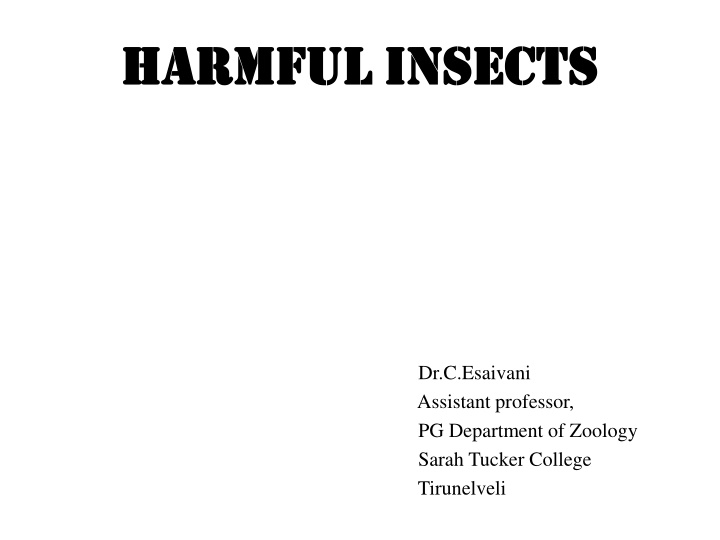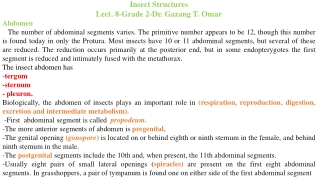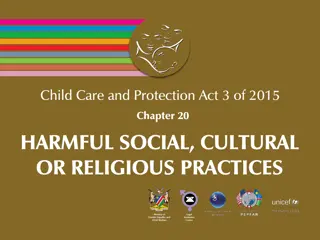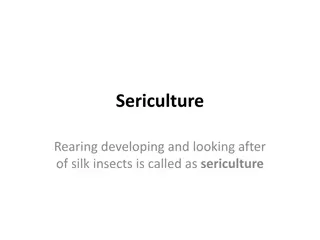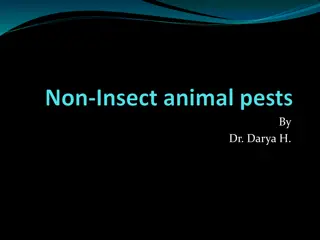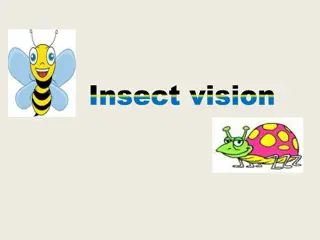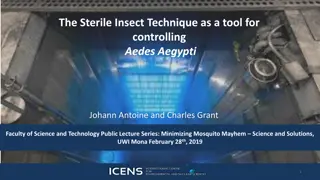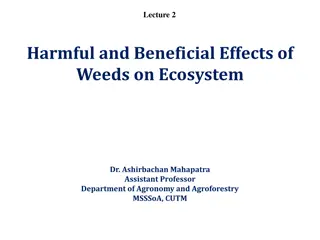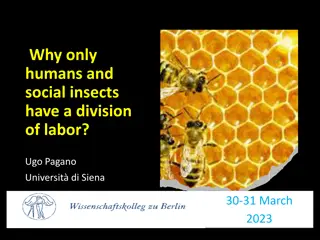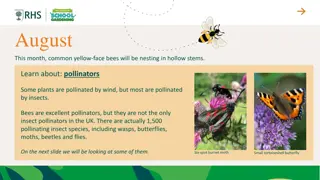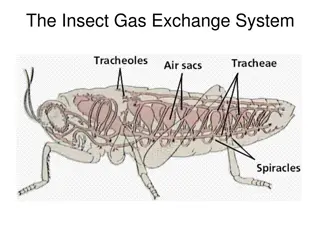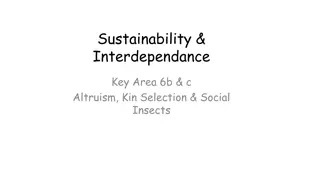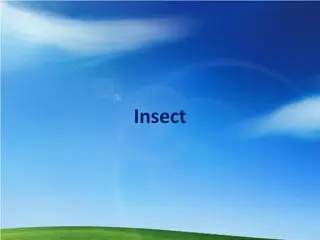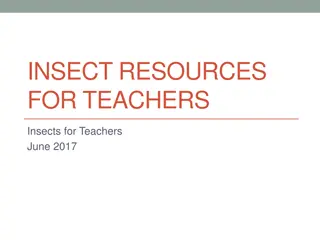Harmful Insects
Harmful insects like mosquitoes and cockroaches pose health risks and nuisance. Mosquitoes transmit diseases including malaria and dengue fever, while cockroaches are common household pests. Learn about their habits, life history, damage caused, and control methods.
Download Presentation

Please find below an Image/Link to download the presentation.
The content on the website is provided AS IS for your information and personal use only. It may not be sold, licensed, or shared on other websites without obtaining consent from the author.If you encounter any issues during the download, it is possible that the publisher has removed the file from their server.
You are allowed to download the files provided on this website for personal or commercial use, subject to the condition that they are used lawfully. All files are the property of their respective owners.
The content on the website is provided AS IS for your information and personal use only. It may not be sold, licensed, or shared on other websites without obtaining consent from the author.
E N D
Presentation Transcript
HARMFUL INSECTS HARMFUL INSECTS Dr.C.Esaivani Assistant professor, PG Department of Zoology Sarah Tucker College Tirunelveli
MOSQUITOES MOSQUITOES (Culex sp., Aedes sp., Anopheles sp.): Of all the existing pests, mosquitoes are a great nuisance. Five important human diseases viz., malaria, yellow fever, dengue fever, filariasis and encephalitis, are exclusively transmitted by mosquitoes. They also transmit many animal diseases such as fowlpox of poultry, myxomatosis of rabbits, rift valley fever of sheep, encephalitis of horses and birds and heartworms of dogs. Some Important Facts About Mosquitoes: Only female mosquitoes are bloodsuckers, the males being strictly vegetarian they feed on nectar of flowers, juices of fruits and injured plants. Mosquitoes are attracted by light, colour and animals. Black, blue and red are the most attractive colours for Aedes mosquitoes. Most mosquitoes get their blood meal from homeothermal (warm-blooded) animals including man, but some species feed on poiklothermal (cold-blooded) animals too. Birds, bats and dragonflies are natural enemies of mosquitoes.
Beetles, larvae of tabanides, nymphs of damsel and mayflies and fishes (like Gambusia) are predaceous of mosquito larvae and pupae. LIFE HISTORY: The eggs are laid in stagnant dirty waters of ponds, pools and ditches. The larvae are called wrigglers and they are voracious feeders, feeding on algal and fungal spores and bacteria. The pupa resembles a question mark. Its tail terminates in a pair of paddles, which assist the pupa to dive rapidly with jerky motions. An air vesicle is situated between the wings of the adult and provides buoyancy. Air from this vesicle spreads under the pupal skin which with the help of muscular action ruptures the pupal skin to allow the adult to fly out. Male mosquitoes have shorter lifespan than female mosquitoes. Male mosquitoes live for only 1 to 2 weeks whereas female mosquitoes live for 1 month duration.
DAMAGE: Mosquitoes (females) inflict painful bites anywhere on the body. The bite is followed by oedema, vasodilation, occasional haemorrhage, papules, erythema and itching. The saliva of mosquitoes contains an anaesthetic factor which desensitizes the skin of the victim. Mosquitoes serves as a cyclic or mechanical but exclusive vectors of various important human diseases. CONTROL: Mosquitoes can be controlled in the following ways: Elimination of or reduction of their breeding grounds Destruction of the larvae Destruction of the adult mosquitoes Protection against their attack Repellents Several satisfactory mosquito repellents have been developed the more effective ones are oil of citronella, dimethyl phthalate, diethyl toluamide, indalone, etc. These could be applied on the exposed parts of the body.
COCKROACH Cockroaches are cosmopolitan inhabitants of human dwellings. It is the most familiar insect of the household, especially in the kitchen and the storerooms. Usually these insects are seen inhabiting in the warm and moist corners, and are nocturnal in habit. There are many species of cockroaches and the most common species in Tamil nadu are Periplaneta americana, Blatella germanica, B. Orientalis and Supella supellictilium. Periplaneta and Blatella species are common in the kitchen and store houses, while Supella is usually seen in the fridges, cold storage, etc. Cockroaches get into many kinds of food, eat a part of it, discolour and spoil it with faecal material, and leave behind a disagreeable odour. It is a sign of nuisance and unclean conditions. They are omnivorous, feeding on all kinds of materials such as paper, leather, starch and oil.
LIFE HISTORY: The eggs are laid in groups enclosed in a capsule called ootheca, these oothecae are generally carried by females and are deposited in a warm, humid and undisturbed corner. A female lays one ootheca once in 4-5 days and a single female is capable of laying about 15-90 egg-pods and each pod may contain 14-16 eggs. The eggs undergo development, and depending on the environmental condition the egg development is completed in 15-100 days. The eggs hatch, and the young ones resemble their adults except for their size but without wings. Hence they are called nymphs. The nymphal development is slow and takes 10-16 months to complete the development. The habit, repulsive appearance, bad odour and their role in transmitting and spreading of diseases forces us to opt for some control measures for cockroaches.
P. Americana has been established to be an intermediate host for Moniliformis dubius which is found in man. The cockroaches are the carriers of several nematodes, and E. histolytica, the causal agent of amoebiasis in man. They are also suspected to carry organisms producing diseases like Cholera, Leprosy, Tuberculosis, etc. CONTROL: The most effective method of prevention of cockroach infestation is scruplous cleanliness and guarding against reinfection. Spot spray or baiting with propurux is very effective. Baits like Baygon granules are to be placed in the infested area in the night. Finit liquid spray ( a combination of pyrethrin and Malathion) can also be used. Even if the cockroaches are successfully removed from the house it will remain so because these insects regularly migrate from the neighbouring areas. Hence, periodical checking for infestation and control is essential.
APHIDS Biological name: Aphis gossypii Pest Status: It is a potential pest of cotton. The aphids live under the surface of leaves in very large numbers and suck the sap of the plant. Hence, this infestation results in curling of leaves, stunted growth and gradual drying and death of young plants. Aphids secrete certain honey-dew like secretions. Biology of the Pest: The aphids are greenish brown, soft-bodied and small insects. The female insects are apterous (without wings). They multiply parthenogenetically and viviparously. In a day, a female insect can give birth to 8-22 nymphs. The nymphal duration is 7-9 days. After nine days, they become adults.
Control Measures: Mechanical Control: The infested leaves may be collected and destroyed. Cultural Control: Soon after harvest, all the cotton sticks are uprooted and destroyed. The fields are irrigated and deep-ploughed. Chemical Control: Demethoate, Phosalone, Methyl demethon, Thimeton, Methyl parathion and Monocrotophos are highly effective pesticides against aphids. Biological Control: The coccinellid beetles Menochilus sexmaculatus and Coccinella septumpunctata are some common insect predators of this pest. These predators can be cultured in the lab and released into the field.
RHINOCEROS BEETLE Biological Name: Oryctes rhinoceros Pest Status: It is one of the most important and major pests of coconut palms. The adult beetles burrow the tender crown by remaining in between leaf sheaths near the crown and thus cut across the leaf in its folded condition. The infested leaves have a series of holes or the leaflets may appear as if cut by shears. Pineapple, sugar cane, date palm, palmyrah, etc are also attacked by this insect. Biology of the Pest: The adult is stout, black or reddish black and 40-50mm long and 14-21mm wide. It has a long horn projecting dorsally from the head in male. In the female the horn is short. A female may lay up to 140 eggs. The incubation period is 8-18 days.
They lay the eggs on mature pits, cow dung heaps, etc. The grubs hatch out from the eggs. They feed on the decaying matter. The grubs are not harmful or infectious, they just grow on manure pits. There are three larval instars. The larval period is from 74-91 days. The grubs pupate in earthen cells at a depth of 0.3 to 1m and the pupal period is 10-25 days after which they emerge as adults. The adult longevity extends up to 290 days. Control Measures: Mechanical control: Remove the sources of breeding by burning or burying deep the decaying vegetable matter. The beetles can be removed from crowns by means of beetle hooks (iron hooks). Decaying tree trunks should be burnt. Baits or traps can be used. Castor cake soaked in water in a small mud pot also forms an effective trap for the adult beetles.
Chemical control: Carbaryl and diflubenzuron are effective against these beetles. Biological control: The grubs are susceptible to the fungi Metarrhizium anisopliae and Beauveria bassiana. The reduviid bug, Platymeris laevicollis appears to be a promising predator for this insect. The histerid beetle, Santalus parallelus, is the predator for the eggs and first instar grubs.
Thank you Thank you
